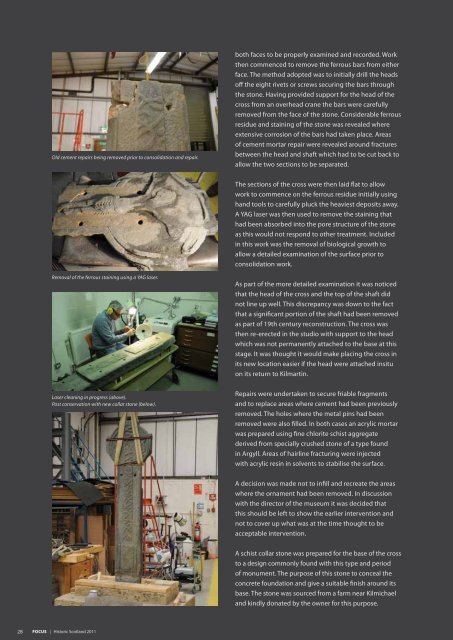informing the conservation of the built env ironment - Historic Scotland
informing the conservation of the built env ironment - Historic Scotland
informing the conservation of the built env ironment - Historic Scotland
Create successful ePaper yourself
Turn your PDF publications into a flip-book with our unique Google optimized e-Paper software.
Old cement repairs being removed prior to consolidation and repair.<br />
both faces to be properly examined and recorded. Work<br />
<strong>the</strong>n commenced to remove <strong>the</strong> ferrous bars from ei<strong>the</strong>r<br />
face. The method adopted was to initially drill <strong>the</strong> heads<br />
<strong>of</strong>f <strong>the</strong> eight rivets or screws securing <strong>the</strong> bars through<br />
<strong>the</strong> stone. Having provided support for <strong>the</strong> head <strong>of</strong> <strong>the</strong><br />
cross from an overhead crane <strong>the</strong> bars were carefully<br />
removed from <strong>the</strong> face <strong>of</strong> <strong>the</strong> stone. Considerable ferrous<br />
residue and staining <strong>of</strong> <strong>the</strong> stone was revealed where<br />
extensive corrosion <strong>of</strong> <strong>the</strong> bars had taken place. Areas<br />
<strong>of</strong> cement mortar repair were revealed around fractures<br />
between <strong>the</strong> head and shaft which had to be cut back to<br />
allow <strong>the</strong> two sections to be separated.<br />
The sections <strong>of</strong> <strong>the</strong> cross were <strong>the</strong>n laid flat to allow<br />
work to commence on <strong>the</strong> ferrous residue initially using<br />
hand tools to carefully pluck <strong>the</strong> heaviest deposits away.<br />
A YAG laser was <strong>the</strong>n used to remove <strong>the</strong> staining that<br />
had been absorbed into <strong>the</strong> pore structure <strong>of</strong> <strong>the</strong> stone<br />
as this would not respond to o<strong>the</strong>r treatment. Included<br />
in this work was <strong>the</strong> removal <strong>of</strong> biological growth to<br />
allow a detailed examination <strong>of</strong> <strong>the</strong> surface prior to<br />
consolidation work.<br />
Removal <strong>of</strong> <strong>the</strong> ferrous staining using a YAG laser.<br />
As part <strong>of</strong> <strong>the</strong> more detailed examination it was noticed<br />
that <strong>the</strong> head <strong>of</strong> <strong>the</strong> cross and <strong>the</strong> top <strong>of</strong> <strong>the</strong> shaft did<br />
not line up well. This discrepancy was down to <strong>the</strong> fact<br />
that a significant portion <strong>of</strong> <strong>the</strong> shaft had been removed<br />
as part <strong>of</strong> 19th century reconstruction. The cross was<br />
<strong>the</strong>n re-erected in <strong>the</strong> studio with support to <strong>the</strong> head<br />
which was not permanently attached to <strong>the</strong> base at this<br />
stage. It was thought it would make placing <strong>the</strong> cross in<br />
its new location easier if <strong>the</strong> head were attached insitu<br />
on its return to Kilmartin.<br />
Laser cleaning in progress (above).<br />
Post <strong>conservation</strong> with new collar stone (below).<br />
Repairs were undertaken to secure friable fragments<br />
and to replace areas where cement had been previously<br />
removed. The holes where <strong>the</strong> metal pins had been<br />
removed were also filled. In both cases an acrylic mortar<br />
was prepared using fine chlorite schist aggregate<br />
derived from specially crushed stone <strong>of</strong> a type found<br />
in Argyll. Areas <strong>of</strong> hairline fracturing were injected<br />
with acrylic resin in solvents to stabilise <strong>the</strong> surface.<br />
A decision was made not to infill and recreate <strong>the</strong> areas<br />
where <strong>the</strong> ornament had been removed. In discussion<br />
with <strong>the</strong> director <strong>of</strong> <strong>the</strong> museum it was decided that<br />
this should be left to show <strong>the</strong> earlier intervention and<br />
not to cover up what was at <strong>the</strong> time thought to be<br />
acceptable intervention.<br />
A schist collar stone was prepared for <strong>the</strong> base <strong>of</strong> <strong>the</strong> cross<br />
to a design commonly found with this type and period<br />
<strong>of</strong> monument. The purpose <strong>of</strong> this stone to conceal <strong>the</strong><br />
concrete foundation and give a suitable finish around its<br />
base. The stone was sourced from a farm near Kilmichael<br />
and kindly donated by <strong>the</strong> owner for this purpose.<br />
28 FOCUS | <strong>Historic</strong> <strong>Scotland</strong> 2011











![Elgin Cathedral Wedding Brochure [pdf, 544kb] - Historic Scotland](https://img.yumpu.com/22301571/1/190x151/elgin-cathedral-wedding-brochure-pdf-544kb-historic-scotland.jpg?quality=85)




